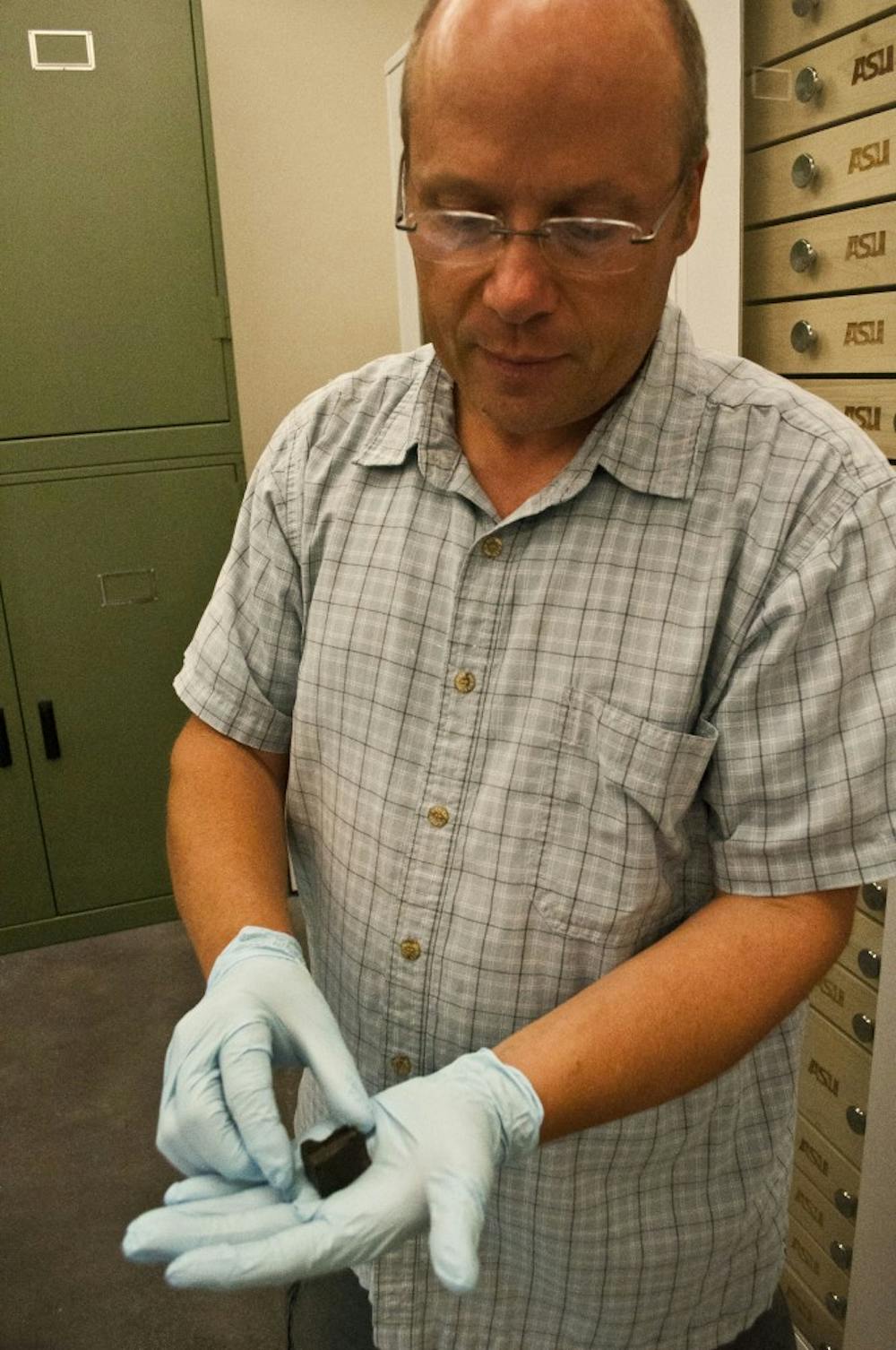 Dr. Laurence Garvie shows the new addition to the collection of minerals occupying the Interdisciplinary 4 building. This meteorite was broken and shared with a few other institutions to study. (Photo by Katie Dunphy)
Dr. Laurence Garvie shows the new addition to the collection of minerals occupying the Interdisciplinary 4 building. This meteorite was broken and shared with a few other institutions to study. (Photo by Katie Dunphy)On the morning of April 22, 2012, a loud sonic boom was heard in the mountains over Placerville, Calif. The Sutter’s Mill meteorite penetrated deep enough into the Earth’s atmosphere over California and Nevada that it exploded into a bright fireball and broke into many pieces.
One of these pieces has made its way to ASU's Center of Meteorite Studies.
The Sutter’s Mill meteorite has an estimated age of 4.5 billion years, and is a carbonaceous chondrite meteorite, one of the most primitive known.
Research professor Laurence Garvie, who is part of the team that is studying the meteorite, said it can give insights into the formation conditions of the solar system.
"The meteorite is unlike any ever found or studied before,” he said. “It is really important it was found.”
Meenakshi Wadhwa, director of the Center for Meteorite Studies, said there is an educational value in obtaining this rock for ASU.
“ASU is known worldwide for having the largest collection of meteorites of any university in the world,” Wadhwa said. “It is important from an educational standpoint and excellent resource scientifically worldwide.”
Robert Haag, better known as “Meteorite Man,” is responsible for the consortium of institutions having this rare piece of history.
“I went out three times hunting for pieces and let it be known I’d pay whatever it took to get a piece,” Haag said. “This guy found it, and I bought it from him.”
Haag couldn’t help but let researchers and scientists have the opportunity to study the meteorite.
“This is one of the most exotic things to fall from the sky, and it needs to go to these institutions for study,” Haag said.
The Sutter’s Mill meteorite will provide a glimpse into the past of the solar system and help researchers better understand the origins.
The meteorite is a window into the early solar system and is probably older than the Earth, Garvie said.
“The Earth was probably still in its embryonic stage when this rock was formed,” he said.
Ninety stones have been found, and the largest piece weighing 205 grams was preserved for the consortium between the five institutions for study.
The studies into the meteorite’s composition began before ASU acquired a piece of the rock.
“Before we even cut into it there was a CT scan done to see inside," Wadhwa said. "This is the first time this has been done and was possible due to the collaborative effort of the consortium."
This uniquely carbon-rich meteorite doesn’t fit in with other known meteorites. It is different in both content and texture, Wadhwa said.
Scientists are hoping this meteorite will give insight into the formation conditions of the solar system and open other windows into the early solar system.
The carbon-rich material which has been found in the meteorite helps provide a look at materials that may have helped begin life on Earth, Wadhwa said.
“It is possible this kind of material brought the basis for life to our planet,” Wadhwa said. “This material may have contributed to raw materials from which the necessary chemistry for origin of life was needed.”
The meteorite gives information to researchers on planetesimal formation, Garvie said.
“This meteorite can help tell the story of how planets formed in the early beginnings of the solar system," Garvie said. "It gives us information on planetesimal formation.”
Curtis Williams, a geological sciences graduate student, said he believes meteorites like these and other examples at CMS provide great opportunities for learning.
“It’s incredible the samples that are made available here,” Williams said. “The ability to take a close look at them gives us more insight into how our planet was formed and the hazards along the way.”
With the knowledge being gained from the meteorite there is still more to learn, said Wadhwa.
“We don’t understand it all, but this can help better understand these beginnings,” she said.
Reach the reporter at jshanco2@asu.edu or follow him on Twitter @Joey_Hancock




